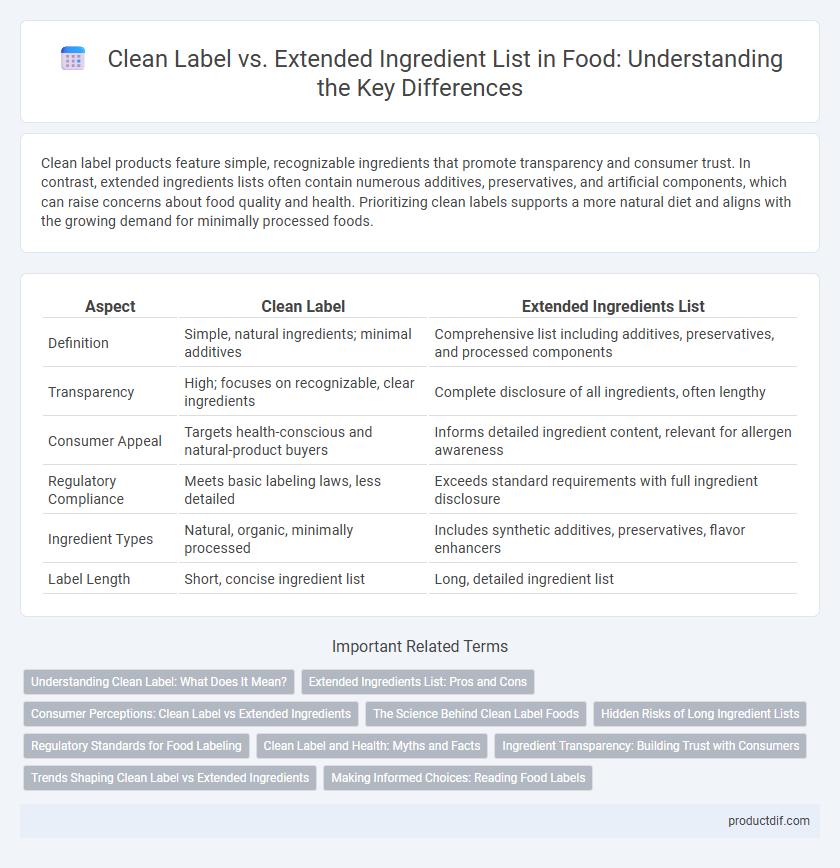Clean label products feature simple, recognizable ingredients that promote transparency and consumer trust. In contrast, extended ingredients lists often contain numerous additives, preservatives, and artificial components, which can raise concerns about food quality and health. Prioritizing clean labels supports a more natural diet and aligns with the growing demand for minimally processed foods.
Table of Comparison
| Aspect | Clean Label | Extended Ingredients List |
|---|---|---|
| Definition | Simple, natural ingredients; minimal additives | Comprehensive list including additives, preservatives, and processed components |
| Transparency | High; focuses on recognizable, clear ingredients | Complete disclosure of all ingredients, often lengthy |
| Consumer Appeal | Targets health-conscious and natural-product buyers | Informs detailed ingredient content, relevant for allergen awareness |
| Regulatory Compliance | Meets basic labeling laws, less detailed | Exceeds standard requirements with full ingredient disclosure |
| Ingredient Types | Natural, organic, minimally processed | Includes synthetic additives, preservatives, flavor enhancers |
| Label Length | Short, concise ingredient list | Long, detailed ingredient list |
Understanding Clean Label: What Does It Mean?
Clean label refers to food products made with simple, recognizable ingredients that consumers perceive as natural and minimally processed. It emphasizes transparency, avoiding artificial additives, preservatives, and complex chemical names often found in extended ingredients lists. By prioritizing familiar ingredients, clean label products cater to growing consumer demand for healthier, more trustworthy food options.
Extended Ingredients List: Pros and Cons
An extended ingredients list provides transparency by detailing every component, including additives and preservatives, which helps consumers make informed dietary choices and identify potential allergens. However, long ingredient lists can overwhelm shoppers and may create perceptions of artificiality or lower product quality, despite the presence of necessary functional ingredients. Balancing comprehensive disclosure with clear labeling supports consumer trust while maintaining product appeal and compliance with regulatory standards.
Consumer Perceptions: Clean Label vs Extended Ingredients
Consumers often associate clean labels with natural, minimally processed foods free from artificial additives, enhancing product trust and perceived health benefits. In contrast, extended ingredients lists can trigger skepticism due to the presence of unfamiliar or chemical-sounding additives, leading to concerns over food safety and transparency. Brands adopting clean labeling tend to foster stronger emotional connections, influencing purchasing decisions and loyalty.
The Science Behind Clean Label Foods
Clean label foods emphasize the use of natural, recognizable ingredients without artificial additives, prioritizing transparency and consumer trust. Scientific analysis reveals that clean label formulations often leverage minimally processed components and plant-based proteins to maintain taste and shelf stability. Research also shows that extended ingredient lists may include functional additives necessary for preserving texture, flavor, and safety, which clean label alternatives replace with natural extracts and processing techniques.
Hidden Risks of Long Ingredient Lists
Long ingredient lists often conceal artificial additives, preservatives, and allergens that pose health risks to consumers, undermining trust in product safety. Clean label products prioritize transparency by using recognizable, natural ingredients, reducing exposure to chemically complex substances linked to allergic reactions and digestive issues. Awareness of hidden risks in extended ingredient lists promotes informed choices and supports the demand for simpler, minimally processed foods.
Regulatory Standards for Food Labeling
Regulatory standards for food labeling require transparency and accuracy, emphasizing clean label practices that minimize artificial additives and prioritize natural ingredients. Extended ingredients lists, regulated by agencies like the FDA and EFSA, must disclose all components, including preservatives and allergens, ensuring consumer safety and informed choices. Compliance with these standards affects product formulation, marketing claims, and legal accountability in the food industry.
Clean Label and Health: Myths and Facts
Clean label products emphasize simplicity and transparency, often containing fewer ingredients and avoiding artificial additives, which appeals to health-conscious consumers. However, clean label does not always guarantee superior nutritional value or safety, as some natural ingredients may still cause allergies or contain harmful substances. Understanding the distinction between clean label marketing and actual health benefits is crucial for making informed dietary choices.
Ingredient Transparency: Building Trust with Consumers
Ingredient transparency is crucial for building consumer trust by providing clear, honest information about product contents. Clean label products emphasize minimal, recognizable ingredients, appealing to health-conscious shoppers seeking simplicity and naturalness. Extended ingredients lists, when detailed and clearly explained, can also foster trust by openly disclosing additives and processing aids, helping consumers make informed choices.
Trends Shaping Clean Label vs Extended Ingredients
Consumers increasingly demand clean label products featuring recognizable, minimal ingredients that promote transparency and trust. Extended ingredient lists, often perceived as complex or artificial, face scrutiny amid rising health-consciousness and preference for natural formulations. Brands respond by reformulating recipes to balance ingredient simplicity with product functionality, shaping industry trends toward cleaner, shorter ingredient declarations.
Making Informed Choices: Reading Food Labels
Consumers seeking clean label products prioritize short, recognizable ingredient lists free from artificial additives, enhancing transparency and trust. Extended ingredients lists often contain complex names and preservatives, complicating quick assessments of product quality and nutritional value. Understanding these label variations empowers informed choices, promoting healthier eating habits and catering to dietary preferences.
Clean Label vs Extended Ingredients List Infographic

 productdif.com
productdif.com